Home Bird Index Detail
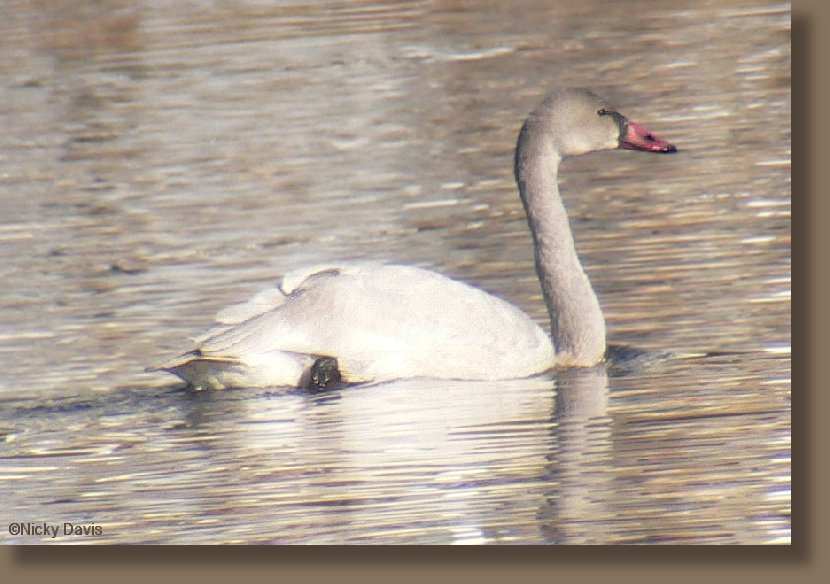
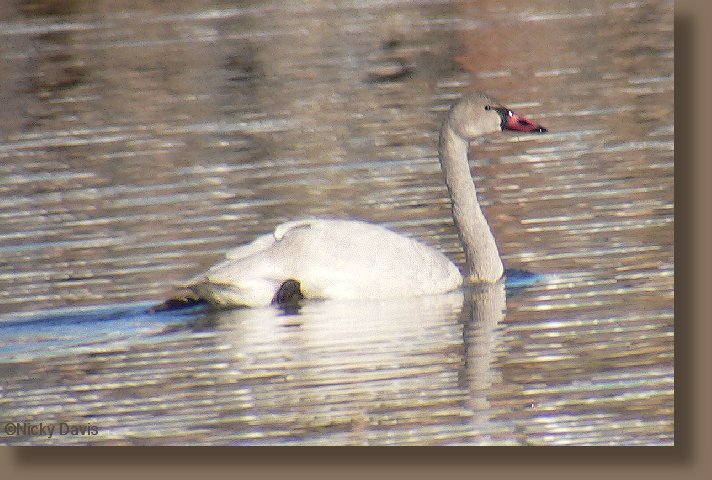
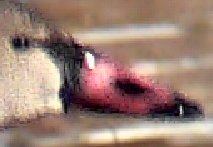
Trumpeter Swan Head
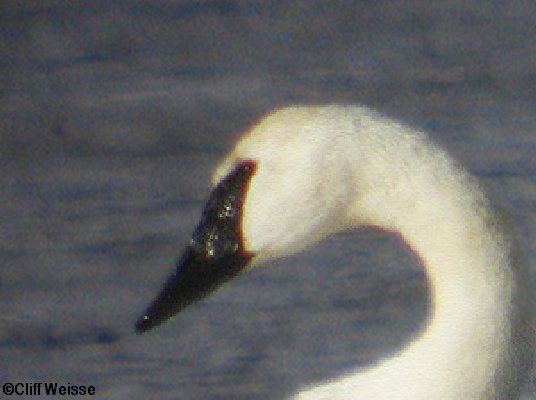
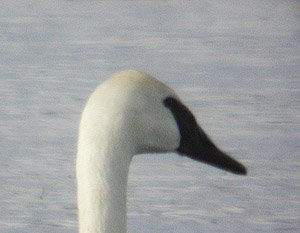
|
Photo Details
1. 2., Juvenile - January 5, 2006 - Salem, Utah County, Utah - ©Nicky Davis 3. a blow-up of the Swan's bill at Salem, Utah 4 .a blow-up of an adult Trumpeter head - Island Park, Idaho - Harriman State Park - ©Cliff Weisse 5 . Adult Trumpeter head - Island Park, Idaho - Harriman State Park - ©Cliff Weisse Description Length 60 inches, wingspan 80 inches, Longer neck and bill than Tundra, long straight bill is always black at base, back is evenly rounded, border between head and bill is pointed, the bill edge is straighter on a trumpeter than on tundra Comments * The bill is pink with black at the tip and base, typical of the Tundra * The back is quite rounded, not flat like a Trumpeter * The wing coverts are white. Tundras molt wing coverts much earlier than Trumpeters. Tundras are usually bright white by January while Trumpeters remain brownish at this time of year. * Legs look black consistent with Tundra. Juvenile Trumpeters have pale legs. * Where the bare skin of the bill meets the feathered skin of the face, the line formed by that junction varies between species. Tundras have more of an angle than Trumpeters. On Tundras the edge of the bare skin extends forward from the eye then curves sharply downward about half way out and continues almost vertical to the base of the bill. On Trumpeters that line is much more gently curved with no sharp turn and doesn't appear to be vertical or perpendicular to the base of the bill. * On this bird, the eyes appear to be separate from the bare skin and connected by a thin line through the lores not integral with the black skin as on a Trumpeter. source - Cliff Weisse ___________________ Bill shape and size fit Trumpeter, as well as the neck width in relation to the body, The other ID point is the length of the wings in relation to the tail. On a Mute Swan the tail would extend 5 maybe 6 inches past the wings, on Trumpeter not more than an 1" or 2". this bird was the latter. source - Tim Avery ___________________ 1. According to Sibley, juvenile trumpeter swans have a bill that is "always black at base" whereas tundra swans have a bill that is "pink at base, becoming black." Examples of this can be seen at http://www.eimagesite.net/s1/gst/run.cgi?action=imagen&prid=310 and to a lesser extent at http://www.schmoker.org/BirdPics/Photos/Waterfowl/TRUS_TUSWcomp1.jpg. In this respect these birds appear similar to the bird illustrated to Sibleys and also to the Salem swan. 2. The head shape of trumpeter swans differs from that of tundra swans. In this I refer to the "Identification of Swans" item in Sibleys, and also to an online article authored by Kevin McGowan entitled "Swan Identification in upstate New York" found at http://www.birds.cornell.edu/crows/SwanID.htm. Dr. McGowan, who spent a number of years as the curator of the birds and mammals collection at Cornell University, articulates the differences in head shapes in the following words: "Trumpeters have a longer, flatter bill, and a more flattened profile and head shape (somewhat Canvasback-like). Tundras have more rounded heads and slightly concave bills." Having actually watched the bird for a number of minutes, as opposed to finding it necessary to rely solely on photographs, I believe the head shape of the bird - which can be seen in the middle photo at http://utahbirds.org/hotlinephotos/TrumpeterSwan.htm - is more clearly consistent with that of a trumpeter than of a tundra swan. 3. In adult birds, according again to Dr. McGowan, "the eye of a Trumpeter looks contained within the black mask of the face, while the eye of a Tundra looks nearly separate, connected only by a small area directly in front of the eye. (This connection can look even narrower because of the yellow lores.) At a quick glance, you can see the position and size of a Tundra Swan's eye easily, while that of a Trumpeter is more hidden." Unfortunately Dr. McGowan does not address the extent to which this is true in juvenile birds and how age might play a role in this aspect of the bird's appearance. I would again refer you to the images mentioned in 1. above, and also to http://www.schmoker.org/BirdPics/Photos/Waterfowl/TRUSjuv3.jpg. Assuming these birds are correctly identified as trumpeters, it seems apparent that in juvenile birds, the black mask is less reliable in differentiating between the two species than in adult birds. 4. I'm not familiar with your observation that begins "edge of feathering," although I do not doubt its correctness. As to the bill-forehead connection, Sibley says simply that in tundra swans there is a "rounded border" whereas in trumpeter swans there is a "pointed border." As to this McGowan elaborates ever so slightly more, stating with reference to a photo about 2/3rds of the way down the page "this is the only forehead shot I have, showing the shallow "U"-shaped forehead of a Tundra Swan. A Trumpeter would have a more V-shaped look with a pointed front border of white into the black, formed presumably by the the more swollen area above the nostrils." In my opinion this is illustrated quite clearly in the bottom photo of the Salem swan found at http://utahbirds.org/hotlinephotos/TrumpeterSwan.htm, especially when compared to the McGowan photo of the tundra swan forehead. 5. As for the matter of flat backs versus arched backs, Sibley states that in trumpeter swans "back tends to be more evenly rounded than Tundra [swans]." McGowan does not comment on this attribute. I have no doubt that you have seen far more of each specie than I have, Cliff, but to me this extent of roundness versus flatness seems to be rather a subjective identifier, i.e., one subject to the interpretation of the observer. In looking at the images sited above and on McGowan's page, I have to confess that I would find myself extremely hard-pressed to differentiate between the species shown on his page based solely on the extent of back-arch. In addition, I find myself wondering if this is always consistent, even within the same bird. Primate postures can change, depending on how animal is carrying itself. One simply has to watch men on a beach, trying to impress women, to see this changing of postures at work. Is this also possible in birds? If so, how ultimately reliable is back shape in swan species differentiation? 6. Coloration seems to indicate that the bird is a juvenile bird, but how far can this be taken? If the Salem bird was born a few weeks earlier or later than the Island Park birds you observed, is it not possible that its coloration would be somewhat out of phase with those birds? And are there other factors, such as genetics, diet, and etc. that might also play a role in the coloration of a juvenile bird at this time of year? I question the value of coloration in juvenile as an objective identification tool in differentiating the species. Cliff, I have followed your posts for a number of years, largely on the Idaho list, and I have a great deal of respect for your opinions. I welcome your feedback, and that of the group if anyone else is interested, and will happily admit that I am wrong if you can prove me incorrect to my satisfaction. Source- Lu Giddings ____________________ I'll do my best to address your arguments individually below. I'll be back in Island Park tomorrow and will try to take some photos of juvenile Trumpeters for comparison. 1. According to Sibley, juvenile trumpeter swans have a bill that is "always black at base" whereas tundra swans have a bill that is "pink at base, becoming black." Since the Salem bird has a black bill base and both Tundra and Trumpeter also have a black bill base I'm not sure this is relevent. Although the cygnet in the photo you referenced at http://www.eimagesite.net/s1/gst/run.cgi?action=imagen&prid=310 shows a similar bill pattern it still has less extensive pink than the Salem bird. Also it's a very young Trumpeter that hasn't fully developed yet. I know the date is Oct 10th but it appears to be a captive bred bird which presumably would make it possible for it to be much younger in Oct than wild Trumpeters would be. Regardless of date the Salem bird has very white wing coverts (back) which Trumpeters won't show until late next summer, when they're more than one year old, at which time the bill will be entirely black. Considering the extent of white on the back the Salem bird would have to have some kind of pigment anomoly to be a Trumpeter with this extent of pink in the bill. You also made reference to a photo on Bill Schmoker's site as follows: "http://www.schmoker.org/BirdPics/Photos/Waterfowl/TRUS_TUSWcomp1.jpg. In > this > respect these birds appear similar to the bird illustrated to Sibleys and also to the Salem swan. In it's original context that photo is actually being used to illustrate the difference in head shape and width of bare lores between Trumpeter and Tundra Swans. Here's what the photo caption says "Head comparison of juvenile Tundra (right- note very narrow lores) and adult Trumpeter Swans...." The URL for this page is http://www.schmoker.org/BirdPics/TRUSs.html, fourth photo down. Just to be clear, the bird on the right is a juvenile Tundra Swan, not a Trumpeter as it came up on a google search. 2. The head shape of trumpeter swans differs from that of tundra swans. In > this I refer to the "Identification of Swans" item in Sibleys, and also to an online article authored by Kevin McGowan entitled "Swan Identification in > upstate New York" found at http://www.birds.cornell.edu/crows/SwanID.htm. Dr. McGowan, .... articulates the differences in head shapes in the following words: "Trumpeters have a longer, flatter bill, and a more flattened profile and head shape (somewhat Canvasback-like). Tundras have more rounded heads and slightly concave bills." I agree that the Salem bird has a flat culmen/bill shape. While the differences mentioned by Kevin and drawm by Sibley are generally true there is variation in these characters in both species. I've seen adult Tundras (yellow spot on lores and all) with very flat bills and obvious Trumpeters with concave bills. Regardless of bill shape the head of Tundra is slightly domed above the eye, as it is in the Salem bird, while Trumpeters have a very flat head essentially continuing the line of the bill all the way to the back of the head where there is a slight peak. Nikcy Davis has added two photos I took last week to the above page. Look at how flat the head is and where the head peaks (far to the rear on Trumpeter) and compare it to the slightly domed appearance of the head on the Salem bird. 3. In adult birds, according again to Dr. McGowan, "the eye of a Trumpeter looks contained within the black mask of the face, while the eye of a Tundra looks nearly separate, connected only by a small area directly in front of the eye. (This connection can look even narrower because of the yellow lores.) Very young Trumpeters on which the feathering is not fully developed would have the eye seperate from the bill as on Tundra. However, as stated above, for a Trumpeter to have this much white in the back it would be over one year old. Even on juvenile Trumpeters, born in 2005, the feathering would be fully developed by January and the eye would not appear seperate from the bill and connected by a thin black line as in the Salem bird. Compare this in the photos on Nicky Davis's page referenced above. You can also see this in one of the photos I referenced in my last post (top photo at http://www.octoberweb.com/birds/whooper/), although not very well. Again I'll try to get some better photos tomorrow. 4. I'm not familiar with your observation that begins "edge of feathering," although I do not doubt its correctness. Again, this is hard to explain. What I'm referring to is where the feathers on the head and face meet the unfeathered bill. If you start near the chin on the bottom of the bill, where the bill meets the feathered throat, if you follow the edge of the feathers upward and it curves back and eventually goes all the way to the eye (and if you contiune around the eye and across the forehead, etc). The shape of this edge differs between species. Sibley draws this difference in the heads of the swans at the right edge of page 73 (Field Guide to North America, not one of the regional guides). On the Trumpeter that's second down from the top, there's a line pointing to the base of the bill that says "straighter edge". On the Tundra directly below that one a line points to the same place and says "curve at gape". This "curve at gape" is clearly visible in the photos of the Salem bird. 5. As for the matter of flat backs versus arched backs, Sibley states that in trumpeter swans "back tends to be more evenly rounded than Tundra [swans]." McGowan does not comment on this attribute. I have no doubt that you have seen far more of each specie than I have, Cliff, but to me this extent of roundness versus flatness seems to be rather a subjective identifier, i.e., one > subject > to the interpretation of the observer. In looking at the images sited above and on McGowan's page, I have to confess that I would find myself extremely hard-pressed to differentiate between the species shown on his page based solely on the extent of back-arch. In addition, I find myself wondering if this is always consistent, even within the same bird. Primate postures can change, depending on how animal is carrying itself. One simply has to watch men on a beach, trying to impress women, to see this changing of postures > at > work. Is this also possible in birds? If so, how ultimately reliable is back shape in swan species differentiation? Your primate posture analogy isn't a good example in my opinion. Apples and oranges. Birds aren't primates and posture varies in different ways. That said the shape of the back is subject to posture to some extent, but the difference is real. Look at the the difference between the Tundra on the left and the Trumpeters on the right in these photos: http://www.muskoka.com/~sinclair/archives/tundtrum.jpg 6. Coloration seems to indicate that the bird is a juvenile bird, but how far can this be taken? If the Salem bird was born a few weeks earlier or later than the Island Park birds you observed, is it not possible that its coloration would be somewhat out of phase with those birds? No. As I mentioned above the timing of obtaining white wing coverts is dramatically different between species. We're talking months, like eight months, not weeks. I question the value of coloration in juvenile as an objective identification tool in differentiating the species. Obviously there is variation as in most, or all, characteristics but the difference is striking and is very useful in first winter juvenile Trumpeter/Tundra identification. There is one more point that I neglected to mention in my last post to Utahbirds. Leg color of juveniles varies between species. Tundras have black legs, Trumpeters have grayish/yellowish legs. The Salem bird clearly has black legs, visible in Nicky Davis's photos. While I'm on the subject of leg color there is one more consideration. Trumpeters have a rare but regular leucistic color morph. These birds appear white as juveniles but have very obviously yellow legs which the Salem bird does not show. I hope all this is helpful. If you still have doubts I recommend you post a query on ID Frontiers. You'll likely get opinions from people with far more experience and knowledge than I have. That's probably your best bet for nailing down the ID. Cheers, Cliff One more thing that apparently differs is the "U" vs "V" shape on the crown. I've read that Tundras don't have a U until they are older and sometimes (often?) show a V when they are young. Cliff More links: http://www.octoberweb.com/birds/trus/ http://www.muskoka.com/~sinclair/archives/tundraim.html http://fog.ccsf.org/~jmorlan/trswid.htm _______________________________ I think that perhaps the most confusing thing about this juvenile bird was the fact that the eye did not seem as "included" in the bill as is seen with most adult Trumpeters. The bare patch connecting the eye seemed thinner, suggesting Tundra. It could have been the coloration of the bill but perhaps it is the age, as Lu suggested. That was the one thing that troubled me the most in looking at a few of the photos. Other minor things were that the bill didn't quite have as much black as the Sibley Western Guide depicts and in some of the brighter photos, the swan's body appeared rather white (suggesting the molt of Tundra). In the photos, I saw other features that suggested Trumpeter but I was finally convinced when I saw firsthand the big, flat-topped bill (not at all concave), the V on the forehead (clearly unlike the Tundra Photo on McGowan's page) and the blocky head. While I don't think this is as diagnostic, the overall coloration was ! browner than some of the photos seem to imply. Lastly, and certainly not diagnostic, was the behavior. The Trumpeter Swan seemed to dance (rocking back and forth) in the shallows along the west side of the pond. This presumably was to stir up all the good food from the muck at the bottom. It was neat to watch very a very shy and submissive Common Goldeneye take advantage of the disturbance. He snuck in and dove and then emerged from behind the swan and swam away as if nothing happened. Good Birding, Matt Williams |
